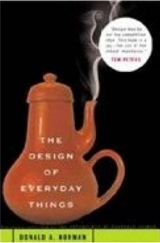


|
The Design of Everyday Things (平装)
by Donald A. Norman
| Category:
Design, Graphic Arts, Industrial design, Web development |
| Market price: ¥ 178.00
MSL price:
¥ 158.00
[ Shop incentives ]
|
| Stock:
Pre-order item, lead time 3-7 weeks upon payment [ COD term does not apply to pre-order items ] |
MSL rating:
 Good for Gifts Good for Gifts |
MSL Pointer Review:
This book should be required reading for software developers and anyone who designs and builds products for human use.
|
| If you want us to help you with the right titles you're looking for, or to make reading recommendations based on your needs, please contact our consultants. |

|
| |
AllReviews |
1 Total 1 pages 5 items |
|
|
Library Journal (MSL quote), USA
<2008-04-17 00:00>
Anybody who has ever complained that "they don't make things like they used to" will immediately connect with this book. Norman's thesis is that when designers fail to understand the processes by which devices work, they create unworkable technology. Director of the Institute for Cognitive Sciences at University of California, San Diego, the author examines the psychological processes needed in operating and comprehending devices. Examples include doors you don't know whether to push or pull and VCRs you can't figure out how to program. Written in a readable, anecdotal, sometimes breezy style, the book's scholarly sophistication is almost transparent. Gregg Sapp, Idaho State Univ. Lib., Pocatello
Copyright 1988 Reed Business Information, Inc. |
|
|
Tom Peters (MSL quote), USA
<2008-04-17 00:00>
A popular, entertaining, and insightful analysis of why some products satisfy customers while others only frustrate them. "This book is a joy - fun and of the utmost importance. |
|
|
Inside Flap Copy, USA
<2008-04-17 00:00>
A popular, entertaining, and insightful analysis of why some products satisfy customers while others only frustrate them.
B & W photographs and illustrations throughout. |
|
|
Jeffrey Sauro (MSL quote), USA
<2008-04-17 00:00>
This is one of the seminal works in the field of User Centered Design. Norman wrote this book well before the Windows operating system was as familiar as the Golden Arches--which only reinforces the idea that certain basic usability principles transcend all forms of objects--from glass doors to Windows Explorer.
Norman does a great job of describing why and how we successfully and unsuccessfully use everyday objects with relevant anecdotes. His stories are usually accompanied with lists of principles that explain good design and account for human behavior. For example, the fundamental principals of designing for people are to: Provide a good conceptual model, make controls visible and to constantly provide feedback to the user.
So how does one employ good user-centered design? Norman recapitulates his points at the end of the book by listing the seven UCD principles for transforming difficult tasks into easy ones:
1. Use both knowledge in the world and in the head
2. Simplify the structure of tasks
3. Make things visible
4. Get the mappings right
5. Exploit the powers of constraints-Natural & Artificial
6. Design for Error
7. When all else fails, standardize
It's mandatory reading for any usability software engineer but also an interesting and well written book for anyone who's ever pushed a "pull door" or scalded themselves in the shower (which is all of us).
|
|
|
C. Gilbert (MSL quote), USA
<2008-04-17 00:00>
Let me start by acknowledging that the book is not perfect. The end notes are annoying and Norman can have a tendancy to ramble and I guess that not everyone would find that charming. However, I assert that the strengths of the book more than make up for its weaknesses- it is an important book, and one that anyone engaged in designing things for other people should read.
The central point is simple- the needs of the user are different from the needs of the designer. The designer might want everyone's actions with his system to be precise, the user might need to have a "good enough" range of precision approximation. The designer wants to make the knobs the same so they look good together, the user wants to be able to tell quickly which knob applies to which function. It's a basic concept that can't (particularly on the Internet today) be repeated often enough.
Norman looks at the kinds of errors people make in usage and discusses how designers can plan to prevent these kind of errors. He discusses some of the basic things that users find valuable and walks the reader through some classic (and often funny, because so recognizable) design errors.
The writing is clean and (with the exception of the aforementioned rambling) very clear. Norman's voice is full of humor and a real passion for the subject, and that voice is conveyed very well by the book.
|
|
|
|
1 Total 1 pages 5 items |
|
|
|
|
|
|